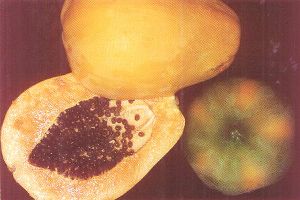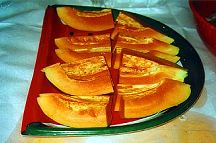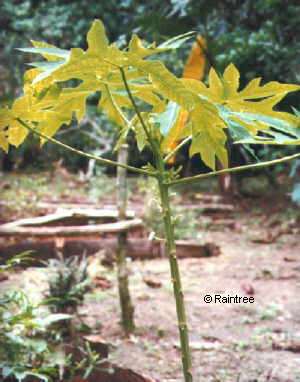|
|
||
 |
 |
|
 |
 |
|
|
|
||
| Papaya | ||
| Genus
|
Family
|
|
|
Note: There seems to be some confusion about whether papaya and pawpaw fruit is the same thing. As you will see below in the common names section it states that papaya is also known as pawpaw. I asked an expert on the subject to clarify for me, and this is what he said,
See also: Pawpaw for illustrations & description |
||
|
Common Names: Papaya, Papaw or Paw Paw (Australia), Mamao (Brazil), Tree Melon. Other names: Chich Put, Fan Kua, Kavunagaci, Lechoso, Lohong Si Phle, Mapaza, Mu Kua, Papailler, Papaw, Papaye, Papayer, Pawpaw Tree, Pawpaw, Pepol, Tinti, Wan Shou Kuo, Betik petik, Gandul, Katela gantung, Kates, Kepaya, Kuntaia Related Species: Babaco (Carica pentagona), Mountain Papaya (C. pubescens), Chamburo (C. stipulata). Origin: The papaya is believed to be native to southern Mexico and neighboring Central America. It is now present in every tropical and subtropical country. DESCRIPTION of FRUIT: There are two types of papayas, Hawaiian and Mexican. The Hawaiian varieties are the papayas commonly found in supermarkets. These pear-shaped fruit generally weigh about 1 pound and have yellow skin when ripe. The flesh is bright orange or pinkish, depending on variety, with small black seeds clustered in the center. Hawaiian papayas are easier to harvest because the plants seldom grow taller than 8 feet. Mexican papayas are much larger the the Hawaiian types and may weigh up to 10 pounds and be more than 15 inches long. The flesh may be yellow, orange or pink. The flavor is less intense than that the Hawaiian papaya but still is delicious and extremely enjoyable. They are slightly easier to grow than Hawaiian papayas. A properly ripened papaya is juicy, sweetish and somewhat like a cantaloupe in flavor, although musky in some types. The fruit (and leaves) contain papain which helps digestion and is used to tenderize meat. The edible seeds have a spicy flavor somewhat reminiscent of black pepper. Medical Botany: "Carica papaya L. Caricaceae. Cultivated. Green fruit eaten cooked; ripe, eaten fresh or in juices. A dozen seed are swallowed as a vermifuge. For constipation, eat half a papaya. Rutter mentions use of papaya for acarosis, enteritis, and tachycardia (RAR). "Chocó" mix the latex with honey as vermifuge. Leaf infusion cardiotonic. "Cuna" use cooked roots for indigestion. Tikuna eat grated immature fruit with 2-6 aspirin, inducing abortion in about two days (SAR). In Piura, the leaf tea is considered digestive and hypotensive; chopped fruits are used as antiseptic (FEO). Brazilians make flower tea for heart and liver (BDS). |
||
